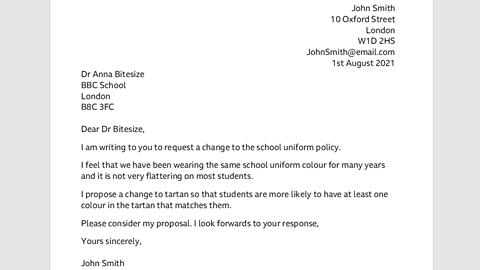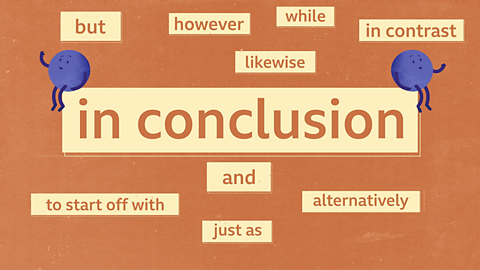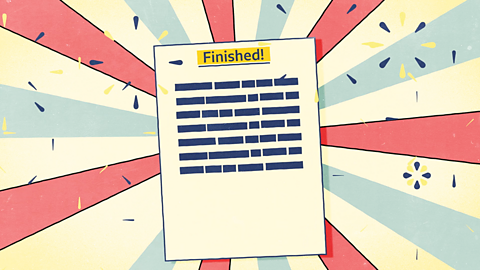What did the envelope say to the stamp?
“Stick with me and we’ll go places!”
Did you know?
The first ever adhesive postage stamp was launched in the United Kingdom in 1840 and was called the Penny Black. It forever changed the way letters were sent.
Introduction to how to write a formal letter

Knowing how to write a formal letter is a very important life skill.
Although a lot of our day-to-day written communication is by email, text message or social media, there are many times you will still need to write a formal letter: to apply for your dream job, make a formal complaint, communicate with companies or customers, or even write to your local Member of Parliament.
In order to do this successfully, you need to know the rules and conventions of writing a formal letter so that you create the right impression.

Video about the layout and language needed in a formal letter
Learn how to write a formal letter using the correct layout and language
Purpose
When writing a formal letter, you need to remain focused on your purpose. Why you are writing the letter should be clear. The reader should be left in no doubt about what it is you are trying to achieve. As such, your letter needs to be precise and to the point.
Think about the purpose of your letter and include all the relevant details to help the reader understand the reason for your writing and respond when required. For example:
- In a job application, include some specific details about why you are an ideal candidate for the role.
- In a letter of complaint, include a formal, matter-of-fact summary of what has happened to prompt your complaint, with details such as names, locations and dates if necessary.
- In a letter to a customer, explain clearly why you are contacting them with details of the services you can or have provided and what it is that they need to do next in order to proceed.
Tone and language
When writing a formal letter, the toneThe sound and feeling of your writing. you create is very important and getting it right can sometimes be difficult.
You need to think carefully about the range and type of language you choose to use. In a formal letter, the aim is to sound businesslike and professional by avoiding any words or phrases that seem casual or chatty, whilst using a range of appropriate vocabulary.
You may need to be firm but it is essential you remain polite throughout, avoiding emotive languageWords chosen to make your reader feel certain emotions. where you can.
Layout and structure
There is a standard way to structure a formal letter that needs to be followed. This can be broken down into three sections:
- Address and date
- Beginning and ending
- Paragraphing
Addresses and date
The address and date should always be at the top of your letter. This makes it easy for the person who receives your letter to know who it was from, when it was sent and how to get back in touch with you.
They should be laid out in this way:
- Your full name should be on the first line.
- Your full address, including postcode, should be underneath this (using separate lines for each new line of your address).
- Your email address should then be immediately underneath this.
- The date (writing the month and year in full) should immediately follow beneath this.
- They should be in the top-right corner of the page, alignedPlaced or arranged in a straight line. to the right.
For example:

The recipientThe person who receives something, the person you are sending something to. name and address should be below this, aligned on the left hand side of the page, laid out in exactly the same way as yours. For example:

What goes where?
Click on the different parts of this example to see what goes where in a formal letter.
Beginning and ending your letter
Beginning:
Most formal letters will start with ‘Dear’ before the name of the person that you are writing to. You can choose to use first name and surname, or titleA noun that a name that describes someone's job, position or status. and surname. However, if you don't know the name of the person you are writing to, you must use ‘Dear Sir or Madam,’.
Whichever way you begin your letter, it must be followed with a comma.
Your opening sentence, which needs to be on a new line, should then clearly state why you are writing the letter - get to the point straight away.
Ending:
How you sign off will depend on how you started your letter. Here are the rules you must follow:
- If you used someone’s name at the start, end with ‘Yours sincerely,’
- If you used ‘Dear Sir or Madam’ instead, end with ‘Yours faithfully,’
Again, whichever way you need to end your letter, it must be followed with a comma.
Paragraphing
The main part of your letter must be divided into paragraphs.
Make sure that each new point you make is given a separate paragraph (bearing in mind that each point is likely to include several sentences). Ensure you remain firmly focused on the overall purpose of your writing.
Planning your letter
Step 1: Write down the overall purpose of your letter – what is the reason for your writing? What are you aiming to do? What outcome do you want?
Step 2: Bullet point the main points you want to make (writing down any key words you might want to use). These may eventually be what you say in each paragraph.
For example:
- Writing to apply for position, making clear I’m attaching my CV for consideration
- Summary of why I’m suitable for role: hardworking, skilled, dedicated, team-player
- Invite them to get in touch if they have any questions or would like further details
Step 3: Make a note of how you are going to begin and end your letter – do you have the recipient’s name? If so, remind yourself that you need to end the letter with ‘Yours sincerely,’. If not, remind yourself that you need to end with ‘Yours faithfully,’.
Step 4: Draft your letter, thinking about where you are placing your addresses and date. Make sure that you have been clear and remained professional and formal throughout, editing where necessary.
Step 5: Proofread your letter, checking your spelling, punctuation and grammar for any mistakes.

Try it yourself
Practice your planning skills:
Plan a formal letter to your headteacher, requesting a change to your school uniform policy. Think about the overall purpose of your letter and the points that you are going to make to outline the need for this change.
Once you have planned this, have a go at writing it up in full, focusing on your formal tone and vocabulary whilst keeping your points clear and precise.
Practice your planning skills:
Plan a formal letter to your headteacher, requesting a change to your school uniform policy. Think about the overall purpose of your letter and the points that you are going to make to outline the need for this change.
Once you have planned this, have a go at writing it up in full, focusing on your formal tone and vocabulary whilst keeping your points clear and precise.

Test your knowledge
Secondary games. gameSecondary games
Have fun playing science, maths, history, geography and language games

More on Non-fiction writing
Find out more by working through a topic
- count1 of 10

- count2 of 10

- count3 of 10

- count4 of 10
